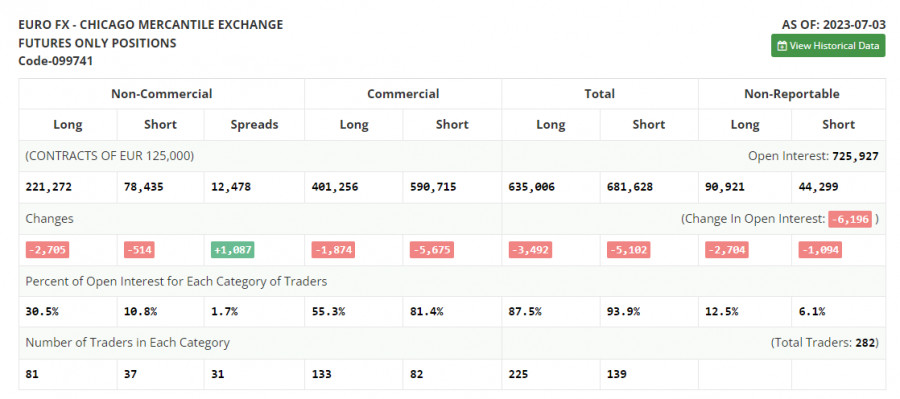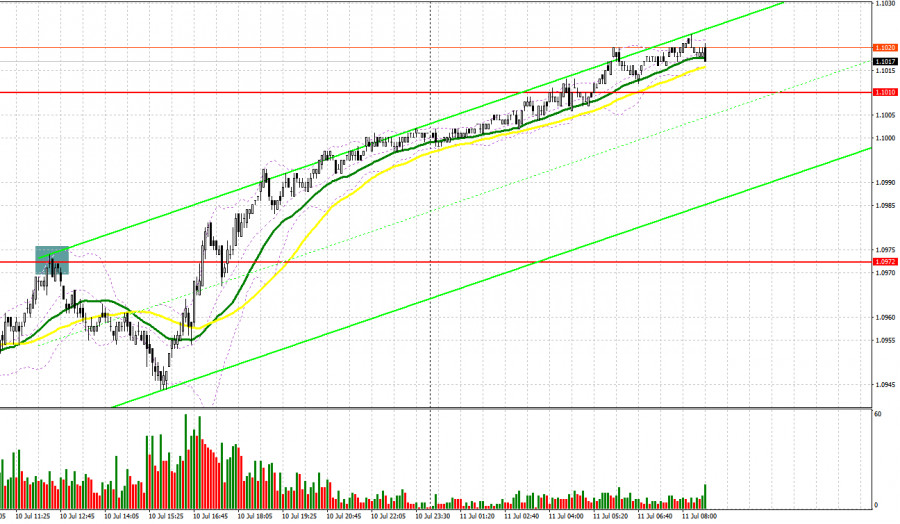
Yesterday, only one market entry signal was formed. Let us take a look at the 5-minute chart and analyze what happened. In my morning forecast, I highlighted the level of 1.0972 and recommended making trading decisions with this level in mind. The rise and formation of a false breakout at this level triggered a sell signal for the euro, resulting in a nearly 30-pip drop. However, in the second half of the day, demand for the euro returned, leading to Friday's bullish scenario.

When to open long positions on EUR/USD:
Before discussing the further prospects of EUR/USD movement, let us have look at what happened in the futures market and the changes in Commitment of Traders positions. The Commitment of Traders (COT) report for July 3 showed that both long and short positions have declined, leaving the market balance practically unchanged. Recent US labor market data indicates initial signs of cooling, which favors risk asset buyers who anticipate further aggressive monetary policies from their respective central banks, unlike the Federal Reserve. Many believe that the expected Federal Reserve interest rate hikes are already priced in, and any data indicating a reduction in price pressure could trigger a significant dollar sell-off. In the current conditions, going long on the euro on dips remains the optimal medium-term strategy. According to the COT report, non-commercial long positions decreased by 2,705 to 221,272, while non-commercial short positions fell by 514 to 78,435. At the end of the week, the overall non-commercial net position slightly declined to 142,837 from 145,028. The weekly closing price dipped to 1.0953 from 1.1006.
Yesterday's comments from US policymakers did not sit well with traders, as they lacked the previous aggression evident in Fed Chairman Jerome Powell's statements. The focus shifted towards recession risks and the need for continued inflation-fighting measures, which the market interpreted as preparations for the final stage of rate hikes in the near future. Tomorrow's US inflation data could also disrupt prevailing market dynamics. Today, in the first half of the day, Germany's consumer price index data will be released, followed by the economic sentiment and current situation index report from the ZEW Institute for both Germany and the eurozone. The data is expected to be negative, which could limit the euro's upside potential.

A surge in buying pressure during the European session will provide an excellent opportunity to increase long positions. I will act around the support level of 1.0985, which was formed at the end of Monday's session. A false breakout of that level will create a buy signal, potentially pushing the pair towards the significant resistance at 1.1022. A breakthrough and a downward retest of this range will strengthen demand for the euro, providing a chance to reach 1.1053. The most distant target remains the area of 1.1090, which would indicate the formation of a new upward trend for the euro. I will take profit there. If EUR/USD declines and bullish traders are idle at 1.0985, bears might act more actively, anticipating a downward correction. The moving averages slightly below 1.0985 are favoring the bulls. Then, only a false breakout of the next support at 1.0946 will provide a buy signal. I will open long positions immediately if EUR/USD bounces off the low of 1.0911, targeting an upward correction of 30-35 pips.
When to open short positions on EUR/USD:
Considering the increasing bullish momentum, the chances of a downward correction today appear quite limited. The only thing that can help in this regard would be very poor statistics from Germany and the eurozone, so bears need to keep the pair below 1.1022. Protecting this level will be a priority task, and an unsuccessful consolidation there will provide a sell signal, potentially pushing EUR/USD towards 1.0985. A consolidation below this range, as well as an upward retest, will pave the way to 1.0946. The most distant target will be the low of 1.0911, where I will take profits. If EUR/USD moves higher during the European session and bears are idle at 1.1022, as expected, the situation will remain under the control of buyers. In that case, I will postpone opening short positions until the pair reaches the next resistance level at 1.1053 and unsuccessfully consolidates there. I will open short positions immediately if EUR/USD bounces off the high of 1.1090, targeting an intraday downward correction of 30-35 pips.
Indicator signals:
Moving Averages
Trading is conducted above the 30-day and 50-day moving averages, indicating further upside potential for the euro.
Note: The author considers the period and prices of the moving averages on the hourly chart (H1), which differ from the general definition of classic daily moving averages on the daily chart (D1).
Bollinger Bands
If EUR/USD declines, support will be provided by the lower boundary of the indicator around 1.0950. In case of an upward movement, the upper boundary of the indicator around 1.1035 will act as resistance.
Description of indicators
Moving average (moving average, determines the current trend by smoothing out volatility and noise). Period 50. It is marked yellow on the chart. Moving average (moving average, determines the current trend by smoothing out volatility and noise). Period 30. It is marked green on the chart. MACD indicator (Moving Average Convergence/Divergence - convergence/divergence of moving averages) Quick EMA period 12. Slow EMA period to 26. SMA period 9 Bollinger Bands (Bollinger Bands). Period 20 Non-commercial speculative traders, such as individual traders, hedge funds, and large institutions that use the futures market for speculative purposes and meet certain requirements. Long non-commercial positions represent the total long open position of non-commercial traders. Short non-commercial positions represent the total short open position of non-commercial traders. Total non-commercial net position is the difference between the short and long positions of non-commercial traders.